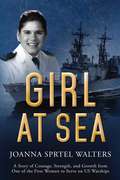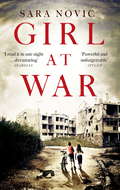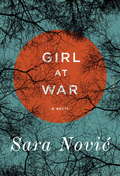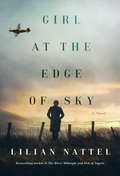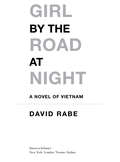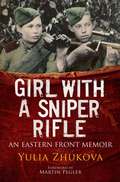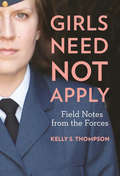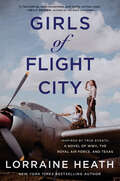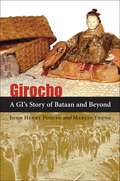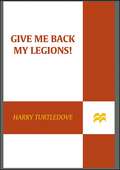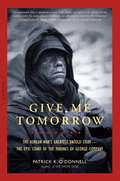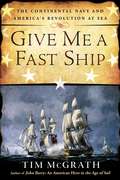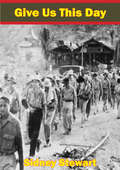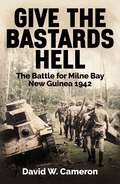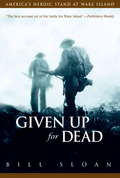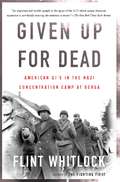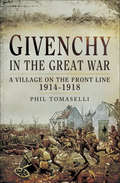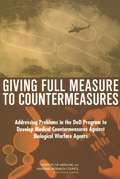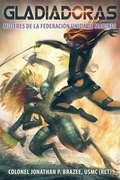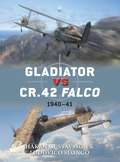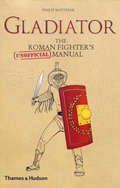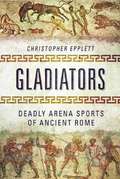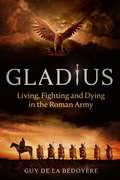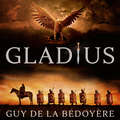- Table View
- List View
Girl at Sea: A Story of Courage, Strength, and Growth from One of the First Women to Serve on US Warships
by Joanna Sprtel WaltersA Naval officer's memoir about finding one's voice. Women have bravely served in the U. S. Navy for nearly a century, but they have only been allowed to serve in combat roles for the last twenty-five years. <P><P>When the combat exclusion law was lifted in 1993, women in the Navy soon had a new range of opportunities available to them. The repeal of the law finally gave women the chance to serve on combatant ships for the first time. Among the first women to step onto these warships as a new crewmember was Joanna Sprtel Walters. In her memoir Girl at Sea, she shares her story beginning with training at the US Naval Academy through her service in the fleet aboard combatant warships. As a member of the class of 1994, she was among the first group of women out of the Academy to have selected warfare specialties. This real-life account sheds light on a ground-breaking time in our country's history as gender barriers continue to be torn down within all divisions of our Armed Forces. Walters's story will resonate with anyone who has ever had to bump their head against a glass ceiling and then fight their way through it. Her story covers difficult topics such as a sexual assault and extortion case at the end of her time at the Academy; struggling to prove herself on a ship where men felt women were invading their spaces; earning the hard-fought respect of her first division; recovering from the career suicide of engaging in a forbidden relationship; fighting to stay in the Navy and then thriving in the most difficult of environments; and her eventual blossoming into a strong Division Officer with an MBA under her belt. Through her successes and failures, Walter's hopes to inspire others to reach beyond what they thought they were capable of and find their own inner strength.
Girl at War
by Sara NovicLONGLISTED FOR THE BAILEYS WOMEN'S PRIZE FOR FICTION 2016Growing up in Zagreb in the summer of 1991, 10-year-old Ana Juric is a carefree tomboy; she runs the streets with her best friend, Luka, helps take care of her baby sister, Rahela, and idolizes her father. But when civil war breaks out across Yugoslavia, football games and school lessons are supplanted by sniper fire and air raid drills. The brutal ethnic cleansing of Croats and Bosnians tragically changes Ana's life, and she is lost to a world of genocide and child soldiers; a daring escape plan to America becomes her only chance for survival. Ten years later she returns to Croatia, a young woman struggling to belong to either country, forced to confront the trauma of her past and rediscover the place that was once her home.
Girl at War: A Novel
by Sara NovicZagreb, 1991. Ana Jurić is a carefree ten-year-old, living with her family in a small apartment in Croatia’s capital. But that year, civil war breaks out across Yugoslavia, splintering Ana’s idyllic childhood. Daily life is altered by food rations and air raid drills, and soccer matches are replaced by sniper fire. Neighbors grow suspicious of one another, and Ana’s sense of safety starts to fray. When the war arrives at her doorstep, Ana must find her way in a dangerous world.<P><P> New York, 2001. Ana is now a college student in Manhattan. Though she’s tried to move on from her past, she can’t escape her memories of war—secrets she keeps even from those closest to her. Haunted by the events that forever changed her family, Ana returns to Croatia after a decade away, hoping to make peace with the place she once called home. As she faces her ghosts, she must come to terms with her country’s difficult history and the events that interrupted her childhood years before.<P> Moving back and forth through time, Girl at War is an honest, generous, brilliantly written novel that illuminates how history shapes the individual. Sara Nović fearlessly shows the impact of war on one young girl—and its legacy on all of us. It’s a debut by a writer who has stared into recent history to find a story that continues to resonate today. <p> <b>Winner of the 2016 Alex Award (10 best adult books that appeal to teen audiences)</b>
Girl at the Edge of Sky
by Lilian NattelGirl at the Edge of Sky is a unique, thrilling, sometimes terrifying novel based on the life and death of Lily Litvyak, a female Soviet flying ace and fighter pilot shot down behind German lines in the Second World War. From the bestselling author of Web of Angels and The River Midnight. Lily Litvyak is no one's idea of a fighter pilot: a tiny, dimpled teenager with golden curls who lied about her age in order to fly. But in the crucible of the air war against the German invaders, she becomes that rare thing--a flying ace, glorified at home and around the world as the White Lily of Stalingrad. The real Lily disappeared in combat in August 1943, and the facts of her life are slim, but they have inspired Lilian Nattel's indelible portrait of a courageous young woman driven by family secrets to become an unlikely war hero. Even more powerfully, Nattel takes another big leap, asking the compelling question: what if Lily survived that last crash and became a prisoner of the Germans? Lily lives in a world of horrifying risk, where the life and death stakes are high in the air, but also on the ground. In the Soviet system, everyone is an informer, even your best friend. Lily lives in constant fear that she will be found out, arrested and executed as the daughter of an "enemy of the people." When she ends up a German prisoner, as a Soviet officer and a Jew, the need for deception becomes even more desperate. Girl at the Edge of Sky is a masterwork of the imagination, subtle and bold all at once, bringing us deep into the precarious life of a remarkable woman who lies to fight for the country that would disown her, and then lies to survive the enemy that would annihilate her.
Girl by the Road at Night
by David RabeDavid Rabe's award-winning Vietnam plays have come to embody our collective fears, doubts, and tenuous grasp of a war that continues to haunt. Partially written upon his return from the war, Girl by the Road at Night is Rabe's first work of fiction set in Vietnam--a spare and poetic narrative about a young soldier embarking on a tour of duty and the Vietnamese prostitute he meets in country.Private Joseph Whitaker, with Vietnam deployment papers in hand, spends his last free weekend in Washington, DC, drinking, attending a peace rally, and visiting an old girlfriend, now married. He observes his surroundings closely, attempting to find reason in an atmosphere of hysteria and protest, heightened by his own anger. When he arrives in Vietnam, he happens upon Lan, a local girl who submits nightly to the American GIs with a heartbreaking combination of decency and guile. Her family dispersed and her father dead, she longs for a time when life meant riding in water buffalo carts through rice fields with her brother. Whitaker's chance encounter with Lan sparks an unexpected, almost unrecognized, visceral longing between two people searching for companionship and tenderness amid the chaos around them.In transformative prose, Rabe has created an atmosphere charged with exquisite poignancy and recreated the surreal netherworld of Vietnam in wartime with unforgettable urgency and grace. Girl by the Road at Night is a brilliant meditation on disillusionment, sexuality, and masculinity, and one of Rabe's finest works to date.
Girl with a Sniper Rifle: An Eastern Front Memoir
by Yulia ZhukovaIn this vivid first-hand account we gain unique access to the inner workings of Stalin's Central Women&’s Sniper School, near Podolsk in Western Russia. Luliia was a dedicated member of the Komsomol (the Soviet communist youth organisation) and her parents worked for the NKVD. She started at the sniper school and eventually became a valued member of her battalion during operations against Prussia. She persevered through eight months of training before leaving for the Front on 24th November 1944 just days after qualifying. Joining the third Belorussian Front her battalion endured rounds of German mortar as well as loudspeaker announcements beckoning them to come over to the German side. Luliia recounts how they would be in the field for days, regularly facing the enemy in terrifying one-on-one encounters. She sets down the euphoria of her first hit and starting her &“battle count&” but her reflection on how it was also the ending of a life. These feelings fade as she recounts the barbarous actions of Hitler&’s Nazi Germany. She recall how the women were once nearly overrun by Germans at their house when other Red Army formations had moved off and failed to tell them. She also details a nine-day stand-off they endured encircled by Germans in Landsberg.
Girls Need Not Apply: Field Notes From the Forces
by Kelly S. ThompsonThis inspiring, compelling debut memoir chronicles the experiences of a female captain serving in the Canadian Armed Forces, and her journey to make space for herself in a traditionally masculine world.At eighteen years old, Kelly Thompson enlisted in the Canadian Armed Forces. Despite growing up in a military family -- she would, in fact, be a fourth-generation soldier -- she couldn't shake the feeling that she didn't belong. From the moment she arrives for basic training at a Quebec military base, a young woman more interested in writing than weaponry, she quickly realizes that her conception of what being a soldier means, forged from a desire to serve her country after the 9/11 attacks, isn't entirely accurate. A career as a female officer will involve navigating a masculinized culture and coming to grips with her burgeoning feminism. In this compulsively readable memoir, Thompson writes with wit and honesty about her own development as a woman and a soldier, unsparingly highlighting truths about her time in the military. In sharply crafted prose, she chronicles the frequent sexism and misogyny she encounters both in training and later in the workplace, and explores her own feelings of pride and loyalty to the Forces, and a family legacy of PTSD, all while searching for an artistic identity in a career that demands conformity. When she sustains a career-altering injury, Thompson fearlessly re-examines her identity as a soldier. Girls Need Not Apply is a refreshingly honest story of conviction, determination, and empowerment, and a bit of a love story, too.
Girls of Flight City: Inspired by True Events, a Novel of WWII, the Royal Air Force, and Texas
by Lorraine HeathInspired by true events, a breathtaking WWII historical novel about the brave American women who trained the British Royal Air Force, by New York Times bestselling author Lorraine Heath.1941. A talented flier, Jessie Lovelace yearns for a career in aviation. When the civilian flight school in her small Texas town begins to clandestinely train British pilots for the RAF, she fights to become an instructor. But the task isn’t without its perils of near-misses and death. Faced with the weight of her responsibilities, she finds solace with a British officer who knows firsthand the heavy price paid in war . . . until he returns to the battles he never truly left behind.Rhonda Monroe might not be skilled in the air but can give a trainee a wild ride in a flight simulator. Fearing little, she dares to jeopardize everything for a forbidden relationship with a charismatic airman… Innocent and fun-loving Kitty Lovelace, Jessie's younger sister, adores dancing with these charming newcomers, realizing too late the risks they pose to her heart. As the war intensifies and America becomes involved, the Girls of Flight City do their part to bring a victorious end to the conflict, pouring all their energy into preparing the young cadets to take to the skies and defeat the dangers that await. And lives from both sides of the Atlantic will be forever changed by love and loss…
Girocho: A GI's Story of Bataan and Beyond
by John Henry Poncio Marlin YoungAfter surviving the brutal Bataan Death March in spring 1942, Louisiana native John Henry Poncio spent the remainder of World War II as a Japanese prisoner, first at Camp Cabanatuan in the Philippines and later at Hirohata in Japan. In those three and a half years, U.S. Army Air Corps sergeant Poncio suffered severe beatings, starvation, disease, and emotional and psychological abuse at the hands of his captors. However, his resiliency, sense of humor, and cunning helped him to persist and to recover from the traumatic events without rancor toward the Japanese. In Girocho, he relates his experiences as a POW with touching honesty, vividly describing the harsh conditions he and his comrades endured as well as the sometimes-funny clashes with Japanese culture. Girocho was a samurai who stole from the rich and gave to the poor, a Japanese Robin Hood. Early on, Poncio was given this name in jest by one of the prison guards, and it suited him perfectly. During his internment, he took part in a vast smuggling operation that brought food, money, mail, and other supplies into the POW camps; he reported enemy troop movements to Filipino guerrillas and participated in acts of sabotage. He and the other prisoners worked together incessantly to subvert the Japanese war effort even under the threat of death, going so far as to bury expensive calibration equipment in wet cement and build irregular gears for planes. To frustrate their captors and to stay alive, the American POWs developed the technique “going Asiatic” — maintaining a blank expression during interrogations and beatings and escaping mentally for a time. Although he and his fellow captives were treated with cruelty by many, Poncio recalls the camaraderie of the prisoners and encounters with humane guards and kind civilians, proving his remarkable gift for finding the positive in the most dire of situations. Girocho is an inspiring memoir, transcribed verbatim by Poncio’s wife, Inez, from nine hours of cassettes Poncio recorded some years after the war. Marlin Young verified her uncle’s stories, placed them in chronological order, and set them within the greater context of the war, creating a compelling tale of one soldier’s courage, honor, and resolve to overcome life as a prisoner of war. Their book is a fitting tribute to the POWs in the Pacific, who fought in their unique way for the U.S. war effort, their friends, and their very lives.
Give Me Back My Legions!: A Novel of Ancient Rome
by Harry TurtledoveAn epic battle pits three Roman legions against Teutonic barbarians in this thrilling novel of ancient Rome from the New York Times–bestselling author.Publius Quinctilius Varus, a Roman politician, is summoned by the Emperor, Augustus Caesar. Given three legions and sent to the Roman frontier east of the Rhine, his mission is to subdue the barbarous German tribes where others have failed, and bring their land fully under Rome's control.Arminius, a prince of the Cherusci, is playing a deadly game. He serves in the Roman army, gaining Roman citizenship and officer's rank, and learning the arts of war and policy as practiced by the Romans. What he learns is essential for the survival of Germany, for he must unite his people against Rome before they become enslaved by the Empire and lose their way of life forever.An epic battle is brewing, and these two men stand on opposite sides of what will forever be known as the Battle of the Teutoberg Forest—a ferocious, bloody clash that will change the course of history.“Turtledove's searing account clears the cobwebs off this ancient and nearly forgotten disaster, and brings it to vivid and startling life for modern readers.” ―Michael Curtis Ford, bestselling author of The Sword of Attila“The fantastic action scenes and taut narrative make this a fine addition to the ancient Roman battles canon.” ―Publishers Weekly
Give Me Liberty
by Rose Wilder LaneIn her youth, Rose Wilder Lane supported the Russian Revolution, but a trip to Russia quickly dispelled her illusions. She realized that the mass politics of socialism necessarily suppressed individual freedom.America was founded on a different principle: individuals should take responsibility for their own lives. On this principle, America became the wealthiest of all nations and the hope of the world. The New Deal of 1933 struck against American individualism, substituting for it the tired collectivist programs of Europe.In Give Me Liberty, originally published in 1936, Lane called for a return to American individualism and a repudiation of the New Deal.
Give Me Tomorrow: The Korean War's Greatest Untold Story -- The Epic Stand of the Marines of George Company
by Patrick O'DonnellOffers the remarkable, but forgotten, story of George Company during the Korean War, an outfit of hastily trained green soldiers that faced an entire division of Chinese troops on the frozen tundra of Chosin Reservoir.
Give Me a Fast Ship: The Continental Navy and America's Revolution at Sea
by Tim McgrathFive ships against hundreds—the fledgling American Navy versus the greatest naval force the world had ever seen… America in 1775 was on the verge of revolution—or, more likely, disastrous defeat. After the bloodshed at Lexington and Concord, England’s King George sent hundreds of ships westward to bottle up American harbors and prey on American shipping. Colonists had no force to defend their coastline and waterways until John Adams of Massachusetts proposed a bold solution: The Continental Congress should raise a navy. The idea was mad. The Royal Navy was the mightiest floating arsenal in history, with a seemingly endless supply of vessels. More than a hundred of these were massive “ships of the line,” bristling with up to a hundred high-powered cannon that could level a city. The British were confident that His Majesty’s warships would quickly bring the rebellious colonials to their knees. They were wrong. Beginning with five converted merchantmen, America’s sailors became formidable warriors, matching their wits, skills, and courage against the best of the British fleet. Victories off American shores gave the patriots hope—victories led by captains such as John Barry, the fiery Irish-born giant; fearless Nicholas Biddle, who stared down an armed mutineer; and James Nicholson, the underachiever who finally redeemed himself with an inspiring display of coolness and bravery. Meanwhile, along the British coastline, daring raids by handsome, cocksure John Paul Jones and the “Dunkirk Pirate,” Gustavus Conyngham—who was captured and sentenced to hang but tunneled under his cell and escaped to fight again—sent fear throughout England. The adventures of these men and others on both sides of the struggle rival anything from Horatio Hornblower or Lucky Jack Aubrey. In the end, these rebel sailors, from the quarterdeck to the forecastle, contributed greatly to American independence. Meticulously researched and masterfully told, Give Me a Fast Ship is a rousing, epic tale of war on the high seas—and the definitive history of the American Navy during the Revolutionary War.INCLUDES NINE MAPS AND SIXTEEN PAGES OF FULL COLOR ILLUSTRATIONS
Give Us This Day [Illustrated Edition]
by Sidney StewartIncludes The Prisoners Of War In Japanese Hands During World War Two pack with 130 photos, plans and photos.In Give Us This Day a young Oklahoman, a survivor of Bataan, reveals the terrible truth about a little-known aspect of the Pacific war as he experienced it from the beginning in the Philippines. He was a captive of the Japanese for more than three years; he knew one after another all the torments of confinement in conditions of primitive barbarism. True though his story is, it almost defies belief. With touching simplicity he recounts the stark and shocking details of one of the most shameful features of that war -- the treatment of American soldiers who fell into the hands of the Japanese. At first Stewart hated his captors, but in the end hatred gave place to a dawning comprehension that the Japanese were as different from us as the men of Genghis Khan."It is one of the most harrowing and debilitating chronicles that I have read. . . . He describes the ordeal brilliantly; he harbors no resentments apparently, and he has emerged from an inferno of bestiality with utter serenity." -- Maxwell Geismar, Saturday Review"An impressive and moving book." -- David Dempsey, New York Times"His is no ordinary prisoner-of-war story; better written than most, it contains no tales of swashbuckling defiance. . . . The force of this book is its testimony to the indomitable strength of the human spirit." -- Manchester Guardian"The plain narrative of this story would by itself have been fascinating, but this book is far more than a story, it is a work of art." -- André Siegfried, Academie Francaise"Sidney Stewart's composed narrative is one of the most noble documents ever penned by a prisoner of war. The companions he writes about remained men to the end, until at last only one man remained; he survived to write this unforgettable, this magnificent story." -- George Slocombe, New York Herald Tribune [Paris]
Give the Bastards Hell: The Battle for Milne Bay, New Guinea 1942
by David W. CameronIn New Guinea&’s jungles, a fierce battle turned the tide of the Pacific War—the first major land defeat for the unstoppable Japanese forces. By mid-August 1942, Imperial Japanese forces dominated the Southeast Asian and Pacific theatres, seemingly unstoppable in their advance. While the Japanese South Seas Force pushed north toward Port Moresby along the Kokoda Track, they launched an operation against Milne Bay at the eastern tip of New Guinea. Their objective: to seize the crucial Allied airfields under construction, which would pave the way for capturing Port Moresby and consolidating their hold on the region. For two intense weeks, Japanese marines, supported by tanks and naval bombardments, battled through the jungle-covered strip of land between the beaches and mountains. Facing them was a determined and diverse Allied force—Australian militia, 2nd AIF troops, American engineers, and, critically, Australian fighter pilots—who fought the Japanese to a standstill near the partially completed Air Strip No. 3. Despite desperate human wave attacks by the Japanese, the Allies held their ground. When the smoke cleared, the Japanese had suffered their first significant land defeat since Pearl Harbor. The Battle of Milne Bay marked a turning point in the Pacific War, signalling the beginning of the end for the Imperial Japanese Empire.
Given Up for Dead: America's Heroic Stand at Wake Island
by Bill SloanA gripping narrative of unprecedented valor and personal courage, here is the story of the first American battle of World War II: the battle for Wake Island. Based on firsthand accounts from long-lost survivors who have emerged to tell about it, this stirring tale of the "Alamo of the Pacific" will reverberate for generations to come. On December 8, 1941, just five hours after the bombing of Pearl Harbor, Japanese planes attacked a remote U. S. outpost in the westernmost reaches of the Pacific. It was the beginning of an incredible sixteen-day fight for Wake Island, a tiny but strategically valuable dot in the ocean. Unprepared for the stunning assault, the small battalion was dangerously outnumbered and outgunned. But they compensated with a surplus of bravery and perseverance, waging an extraordinary battle against all odds. When it was over, a few hundred American Marines, sailors, and soldiers, along with a small army of heroic civilian laborers, had repulsed enemy forces several thousand strong--but it was still not enough. Among the Marines was twenty-year-old PFC Wiley Sloman. By Christmas Day, he lay semiconscious in the sand, struck by enemy fire. Another day would pass before he was found--stripped of his rifle and his uniform. Shocked to realize he hadn't awakened to victory, Sloman wondered: Had he been given up for dead--and had the Marines simply given up? In this riveting account, veteran journalist Bill Sloan re-creates this history-making battle, the crushing surrender, and the stories of the uncommonly gutsy men who fought it. From the civilians who served as gunmen, medics, and even preachers, to the daily grind of life on an isolated island--literally at the ends of the earth--to the agony of POW camps, here we meet our heroes and confront the enemy face-to-face, bayonet to bayonet.
Given Up for Dead: American GI's in the Nazi Concentration Camp at Bergda
by Flint WhitlockDuring World War II, prisoners of war were required by the Geneva Conventions to be treated according to established rules. But in late 1944, when a large number of Americans were captured or surrendered during the Battle of the Bulge and elsewhere, their captors had different plans. Those who were Jewish or from some other "undesirable" ethnic or religious group were separated from their fellow captives and sent to the brutal slave-labor camp at Berga. Until now, the story of what these men endured has been a well-guarded secret.
Givenchy in the Great War: A Village on the Front Line, 1914–1918
by Phil TomaselliThe village of Givenchy-ls-la-Basse sits on a small rise in the Pas de Calais Department in northern France. One hundred years ago it was overtaken by the First World War. The fighting there was intense eleven Victoria Crosses were won in this tiny locality between 1914 and 1918. Phil Tomasellis in-depth account shows what happened at Givenchy when it became a battlefield, and the story here was repeated in the other villages and towns on the Western Front. Givenchys key position made it the target for crushing bombardments, infantry assaults and subterranean warfare. The landscape was pulverized by shellfire, the ground beneath was honeycombed with tunnels. Mining operations, shelling, sniping and trench raids took place around the remains of the village even when this stretch of the front line was relatively quiet. The grueling struggle of attrition that characterized the fighting on the Western Front continued here throughout the war. Phil Tomasellis gripping narrative makes extensive use of war diary extracts, personal stories, official and unofficial histories.
Giving Full Measure to Countermeasures: Addressing Problems in the DoD Program to Develop Medical Countermeasures Against Biological Warfare Agents
by Acquisition of Medical Countermeasures Against Biological Warfare AgentsIn recent years, substantial efforts have been initiated to develop new drugs, vaccines, and other medical interventions against biological agents that could be used in bioterrorist attacks against civilian populations. According to a new congressionally mandated report from the Institute of Medicine and National Research Council of the National Academies, to successfully develop these drugs, vaccines, and other medical interventions against biowarfare agents, Congress should authorize the creation of a new agency within the Office of the Secretary of the U.S. Department of Defense. The committee recommended that Congress should improve liability protections for those who develop and manufacture these products, to stimulate willingness to invest in new research and development for biowarfare protection. Giving Full Measure to Countermeasures also identifies other challenges—such as the need for appropriate animal models and laboratories equipped with high-level biosafety protections—that will require attention if DoD efforts to develop new medical countermeasures are to be successful.
Gladiadoras, Mujeres de la Federación Unida de Marines
by Jonathan P. Brazee Diego PradoLa Cabo Segundo Tamara Veal del Cuerpo de Marines de la Federación Unida llama la atención de los reclutadores que la nominan para servir como Especialista en Combate Mano a Mano. Las gladiadoras, como mejor se las conoce, son las campeonas genéticamente modificadas de la humanidad que enfrentan a las reinas d’relle de los Klethos en el ring de combate cuando los Klethos publican un desafío por un mundo humano. Si triunfa, el planeta se queda en posesión de la humanidad; si pierde, no sólo pierden sus vidas, pero el mundo también. Con los Klethos mucho más avanzados y poderosos militarmente, capaces de derrotar a la humanidad en una guerra total, el ring de desafío es la única manera de retener al menos algunos mundos para el hombre. Mientras la vida como gladiadora está llena del estatus de celebridad y la gratitud de la humanidad, viene con un pesado precio. No sólo existe el riesgo verdadero de la muerte en el anillo, si un gladiador sobrevive a esto, el “Cráter” o Cáncer de Regeneración Acelerada tomará su vida en pocos años. La Cabo Segundo Tamara Veal, quien ha encontrado un hogar en los Marines, tiene que decidir si aceptará la nominación. Tendría que abandonar a sus hermanos y hermanas en el Cuerpo, ingresar al curso de gladiador y someterse a la modificación genética extrema que la dejará casi irreconocible de la mujer que antes era. Hacerse gladiadora le permitirá servir a la humanidad mucho mejor que todo lo que podría hacer como un Marine, pero a un costo personal enorme.
Gladiator vs CR.42 Falco
by Hakan GustavssonBritish and Italian biplanes clashed over the Mediterranean at Crete and Malta, and in East and North Africa early in World War II. Both the Gloster Gladiator and the Fiat CR.42 Falco represented the peak in the development of the biplane fighter, which could trace its lineage back to World War I. However, by the time both aircraft entered service in the late 1930s, they were already obsolete. Nevertheless, they gave sterling service on all fronts in the Mediterranean and Africa in 1940-41. Indeed, the CR.42 was the Regia Aeronautica's staple fighter in both North and East Africa, Greece and over Malta in 1940-41, during which time its pilots routinely fought British and Commonwealth squadrons equipped in the main with Gladiator biplanes. Some bitter dogfights were fought between these two types as the Allies attempted to gain control of the skies over North Africa, Greece and East Africa. Both types were flown in the main by highly experienced pre-war pilots, and this in turn made for some closely fought engagements. The first known combat between the CR.42 and the Gladiator took place on 14 June 1940 over North Africa and the last engagement between the two types occurred on 24 October 1941 over the East African front.
Gladiator: The Roman Fighter's [Unofficial] Manual
by Philip MatyszakAn entertaining yet factual insider's guide: how to become a gladiator, hone your fighting skills, and thrill the crowds in the Colosseum. So you think you'd like to be a gladiator? Find out how to get thousands to idolize you as the strongest, meanest fighter in the Roman empire. Win fame and fortune in one of Rome's most glamorous locations, in the presence of the emperor himself. Who wouldn't kill for a job like that? This handy guide tells you everything you need to know before you step out to fight for your life in front of a roaring crowd: Why you should become a gladiator How to join the most glamorous--yet lethal--profession on earth Who will try to kill you, and with what Which arena of the empire is the right one for you When and how often you will fight What happens before, during, and after a duel Combining the latest research with modern reconstructions, Gladiator helps you experience firsthand the spectacular yet brutal life and death of the most iconic figure of ancient Rome.
Gladiators: Deadly Arena Sports of Ancient Rome
by Christopher EpplettA history of gladiators-with an added bite!It’s hard for modern readers to truly grasp the spectacle that was arena sports in ancient Rome, which pitted man against man and man against beast in mortal combat. Our modern games of football and hockey, or even boxing and MMA, truly pale in comparison. The Gladiators is a comprehensive survey of these ancient sports, focusing on gladiatorial combat and the beast hunts (venationes). While many books have been written on arena spectacles in ancient Rome, they generally neglect the venationes, despite the fact that the beast hunts, of various dangerous wild animals (including lions, tigers, elephants, and rhinos), were almost as popular as gladiatorial spectacles and endured over a longer period of time. Dr. Christopher Epplett gives a full and detailed treatment of both types of spectacle.The author starts by explaining the origins of these bloody combat sports in the late Roman Republic before surveying the growth of these events during the first two centuries of the Empire, when emperors possessed the resources to stage arena spectacles on an unmatched scale. The details of the training, equipment, and fighting styles used by different types of combatants are covered, as are the infrastructure of the arenas and behind-the-scenes organization that was essential to the successful staging of arena events. Particular attention is paid to the procurement of the countless wild animals necessary to stage venationes throughout the Empire. A gladiator book with added bite, The Gladiators is sure to be welcomed by scholars and general readers alike.Skyhorse Publishing, as well as our Arcade imprint, are proud to publish a broad range of books for readers interested in history--books about World War II, the Third Reich, Hitler and his henchmen, the JFK assassination, conspiracies, the American Civil War, the American Revolution, gladiators, Vikings, ancient Rome, medieval times, the old West, and much more. While not every title we publish becomes a New York Times bestseller or a national bestseller, we are committed to books on subjects that are sometimes overlooked and to authors whose work might not otherwise find a home.
Gladius: Living, Fighting and Dying in the Roman Army
by Guy de BédoyèreThe Roman army was the greatest fighting machine the ancient world produced. The Roman Empire depended on soldiers not just to win its wars, defend its frontiers and control the seas but also to act as the engine of the state. Roman legionaries and auxiliaries came from across the Roman world and beyond. They served as tax collectors, policemen, surveyors, civil engineers and, if they survived, in retirement as civic worthies, craftsmen and politicians. Some even rose to become emperors. Gladius takes the reader right into the heart of what it meant to be a part of the Roman army through the words of Roman historians, and those of the men themselves through their religious dedications, tombstones, and even private letters and graffiti. Guy de la Bédoyère throws open a window on how the men, their wives and their children lived, from bleak frontier garrisons to guarding the emperor in Rome, enjoying a ringside seat to history fighting the emperors' wars, mutinying over pay, marching in triumphs, throwing their weight around in city streets, and enjoying esteem in honorable retirement.
Gladius: Living, Fighting and Dying in the Roman Army
by Guy de BédoyèreThe Roman army was the greatest fighting machine the ancient world produced. The Roman Empire depended on soldiers not just to win its wars, defend its frontiers and control the seas but also to act as the engine of the state. Roman legionaries and auxiliaries came from across the Roman world and beyond. They served as tax collectors, policemen, surveyors, civil engineers and, if they survived, in retirement as civic worthies, craftsmen and politicians. Some even rose to become emperors. Gladius takes the reader right into the heart of what it meant to be a part of the Roman army through the words of Roman historians, and those of the men themselves through their religious dedications, tombstones, and even private letters and graffiti. Guy de la Bédoyère throws open a window on how the men, their wives and their children lived, from bleak frontier garrisons to guarding the emperor in Rome, enjoying a ringside seat to history fighting the emperors' wars, mutinying over pay, marching in triumphs, throwing their weight around in city streets, and enjoying esteem in honorable retirement.
